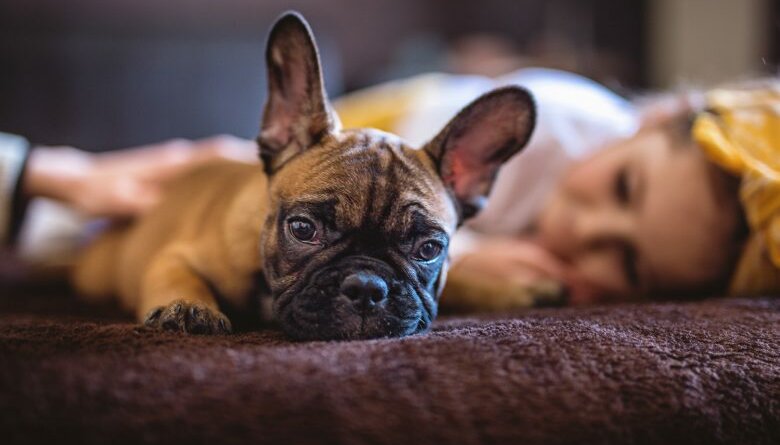Letting Your Puppy Sleep in Your Bed? Here’s How to Do It Safely
I recently had one the best night’s sleep of my life with Indy, an 8-week-old Australian Shepherd puppy. He is a client’s dog and future service animal. He slept draped across my neck and snuggled under my arm. We stayed that way all night long, with only the occasional whimper from Indy when he slipped away from our shared warmth and had to sleepily find his way back. So, why did I let a puppy sleep in my bed, when conventional methods recommend crate training from an early age?
Because puppies sleep in a pile with their siblings right up until you take them home. They get a sense of security from sleeping on top of each other. This is how it is in the womb: warm, quiet and peaceful. Taking them away from their mother and littermates is traumatic. Even when you see a happy, goofy puppy playfully engaging with their new family, keep in mind that they are away from the only home they have ever known, in a completely new environment. When it’s time to sleep, the puppy of course looks for a warm body to snuggle with, and if they are locked in a crate all alone, with no warm littermates and no mother’s heartbeat, it feels cold and quiet and scary.

Sleeping puppies. Photography by Shutterstock.
And the timing of this is typically during a critical period of a puppy’s life: the ages of 8 to 11 weeks, when fear can have damaging and long-lasting effects, including separation anxiety, barking to get attention, sensitivity to noises and confinement and house training issues.
As a service dog trainer, I temperament test puppies and keep them with me until they go to their new guardians for bonding, then they return to me at around 4 months old to begin learning specific tasks. I sleep with puppies at the beginning of their first stay with me while also teaching them to love their crate or ex-pen during waking hours, eventually transferring them to a crate or dog bed right next to mine.
I realize that for some of you, sleeping with a puppy for the first two to three weeks after you bring them home may be completely out of your comfort zone. That is okay and understandable. There are still ways to help your new puppy adjust without locking them in a crate. You can take the top off the crate, putting cushy blankets in so you can reach the puppy when they awaken in the night, touching them quietly while soothing them back to sleep. You can make a bed for you and your puppy on the floor, snuggling together before moving back to your bed when it’s time.
Remember, they aren’t really awake, just looking for warmth, comfort, and security. If they really do need to relieve themselves, they won’t settle back down but will become fully awake, which rarely happens.

Puppy in bed. Photography by Shutterstock.
The point I’m making is that you don’t have to have sleepless nights with yelping pups while you are teaching them to hold it through the night. You can keep the puppy close, creating a safe and secure environment that will result in a happy puppy and well-balanced dog.
I can hear the questions rolling around in your minds. What if I have a 2-pound Maltese pup? I don’t want to roll over and smother her. Of course, you don’t. With tiny pups, opt for the crate next to your bed. And keep in mind, this is just for the first two to three weeks. When your pup knows their new home and that they are loved and feel safe, you can make the transfer to whatever sleeping situation you would like, a crate, a dog bed, whatever works for you.
And don’t worry that you will spoil your dog with the overnight attention. You are making them feel secure, and that is important. My motto is: “You can have a spoiled-rotten, disciplined dog.” Why else do we have them, after all?
Top photograph: FluxFactory/Getty Images
Read Next: Why Are Some Older Dogs Afraid of Young Puppies?




